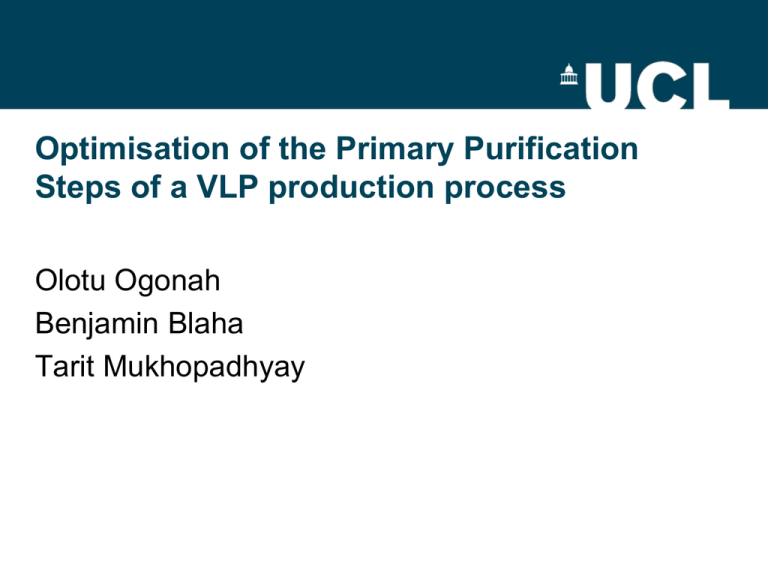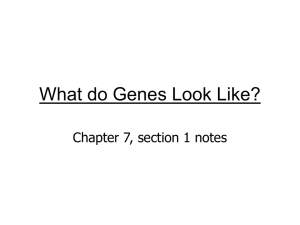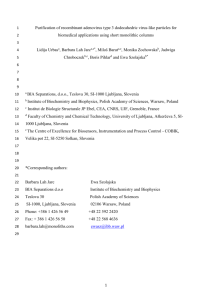UCL - flutcore.eu
advertisement

Optimisation of the Primary Purification Steps of a VLP production process Olotu Ogonah Benjamin Blaha Tarit Mukhopadhyay VLP Process Flow Chart – early phases GSK Stevenage 1 Fermentation and RNA removal 2 Cell harvesting Centrifugation 3 Homogenisation 4 5 Clarification Centrifugation/Normal flow filtration 0.45, and 0.2 m Concentration/Diafiltration HF TFF: NMWC 100kDA Identification of the Critical Process Parameters (CPP): parameters that impact process performance. Homogenisation • The Lab40 is a validated scale down model to the Manufacturing scale – Use process knowledge and expertise to suggest critical process parameters (CPP): parameter which impact process behaviour (response) or critical product quality attributes (CQA). – Will confirm through model building. • In these experiments the responses evaluated will be selected for their potential impact on process efficiency and scalability; i.e. soluble vlp recovered and DNA concentration. Homogenisation screening experiment design – model building. # Homog. pass • • • MODDE software used to enhance the design of screening experiments. • These experiments will identify parameters which have a statistically significant impact on process efficiency. Model VLP → GFP insert. • GFP concentration will be used for a surrogate for VLP/core concentration. Parameter range Name Abbr. Homogenisation pass# pass pH pH • • Units Settings 2, 3, 4 Precision 0.05 7.5, 8, 8.5 0.1 pressure bar bar 300 to 1000 10 detergent % solids Tri %_sol % 0.1 to 1 3 to 15 0.1 0.2 Responses: GFP concentration and DNA concentration. Create a model which describes process behaviour. 4 4 3 3 3 4 2 4 3 3 3 4 4 2 2 3 2 3 3 2 2 2 4 4 3 3 2 2 2 4 2 4 2 3 GFP yield flur. Units 3.0 4159.9 15.0 1586.6 9.0 3993.3 9.0 4453.3 3.0 14426.6 15.0 3973.3 15.0 3499.9 3.0 12013.3 15.0 6186.6 15.0 2066.6 15.0 1586.6 15.0 3853.3 3.0 9199.9 15.0 959.9 15.0 2753.3 9.0 3726.6 3.0 14213.3 3.0 7106.6 3.0 953.3 3.0 226.6 3.0 4979.9 3.0 2208.4 3.0 4568.4 15.0 938.9 9.0 2815.7 9.0 2959.1 3.0 4907.7 15.0 5951.7 15.0 758.7 15.0 9099.1 15.0 2049.7 3.0 8303.1 3.0 948.8 9.0 3078.4 Pressure Detergent % solids bar % (w/w) pH 7.5 8.0 8.0 8.0 8.5 8.5 8.5 8.0 8.0 8.5 7.5 7.5 8.5 8.0 7.5 8.0 8.5 8.0 7.5 7.5 8.0 8.5 8.5 7.5 8.0 8.0 7.5 8.5 7.5 8.5 8.5 7.5 7.5 8.0 650.0 300.0 650.0 650.0 1000.0 650.0 650.0 1000.0 1000.0 300.0 650.0 1000.0 300.0 300.0 1000.0 650.0 1000.0 650.0 300.0 300.0 650.0 300.0 300.0 300.0 650.0 650.0 1000.0 1000.0 300.0 1000.0 300.0 1000.0 300.0 650.0 0.1 1.0 0.6 0.6 0.1 0.1 0.6 0.6 0.1 0.6 1.0 0.6 1.0 0.1 1.0 0.6 1.0 1.0 0.6 0.1 0.6 0.1 0.1 0.1 0.6 0.6 0.1 0.1 0.1 1.0 1.0 1.0 1.0 0.6 DNA mg/l 24.1 29.0 37.0 46.1 43.4 59.6 52.2 46.9 107.4 23.5 31.5 122.4 31.3 16.4 102.9 54.6 43.2 24.5 7.7 5.3 18.0 Actual vs predicted plots (DNA and GFP) Graphical presentation of model terms: The scale and centred coefficients can be used to evaluate the significance of the model terms. Impact of homogenisation pass # on GFP yield 3 passes • 3% load →1.74 X (V/V) than 15% loading. • 3% load →8.75 X (g/g) than 15% loading. • Re-evaluation of initial fermentation data reveal low vlp yield was an artefact of the homogenisation conditions used. • Reducing loading from 15%→ 6% solids increases soluble VLP → ~ 55%) 4 passes Inter-fermentation analysis: VLPs MeOH 30°C (Lab40) Mixed 20°C (Lab40) MeOH 20°C (Lab40) MeOH 20°C (Soni.) Fluorescence 6% load 48 S I S I S I S I 21 Western blots (AB – HepB core protein) Impact of # of homogenisation passes on DNA levels 3 passes • • • 4 passes High DNA contamination. Allowable DNA content for final formulated product ~ <10 ng/dose. Data suggests need for a DNA removal step. The story so far…….. • Homogenisation: – – – – • ↑pH, ↑pass#, and ↑pressure increases vlp release. Low % solids (3%) gives better vlp release (8 fold (wt./wt.) increase) compared to current protocol. ↑ % Load, ↑homogenisation pass #, and ↑pressure increase total DNA released. High genomic DNA contamination indicate DNA removal step will be necessary. • Floculation • Precipitation • AIEX Fermentation – – – 3 batches run under different conditions. Yields and quality (multiple bands on western) impacted by fermentation conditions. • Repeating assays with 6% load during homogenisation ( instead of 15%) reinforces impact of homogenisation conditions on yield. GFP assay appears to overestimates soluble fraction compared to western. • Assay measure total (free and vlp attached) GFP, hence amplified signal ? • Need assays to distinguish between free and attached antigen (Octet ?). Use as measure of stability? Next….. TFF Akta Crossflow What is Tangental Flow Filtration (TFF)? •TFF - Fluid continuously sweeps the membrane surface, recirculating the feed stream across the membrane. Advantages •Minimizes clogging membrane pores (fouling) and promotes consistent, long-term productivity. •Units can be cleaned, stored, and re-used as needed; i.e. it is very cost effective. • Suitable for scale-up •Two types •Cassettes: High shear, High flux → Higher ∆P •Hollow Fibre: Low shear, lower flux than cassettes. Suitable for fouling feed streams. Hollow Fibre vs Cassettes: Initial Flux vs TMP Flux vs . T M P Ru n 3 - 2 5 ml/m in Ru n 3 - 3 5 ml/m in Ru n 3 - 5 0 ml/m in 70 60 50 F l u x [ LM H ] 40 30 20 10 0 0 .2 0 .3 0 .4 0 .5 0 .6 0 .7 0 .8 TMP [ b a r] 0 .9 1 .0 1 .1 1 .2 Flux vs. T M P Run 16 - 250 ml/min (8000/s) 60 Run 16 - 125 ml/min (4000/s) Run 16 - 63 ml/min (2000/s) 55 50 45 40 F lux [ LM H ] 35 30 25 20 15 10 0.1 0.2 0.3 0.4 0.5 0.6 0.7 TMP [ bar] 0.8 0.9 1.0 1.1 1.2 1 .3 At large scale systems are run in constant flux mode in linear (non fouling) region of the flux vs TMP curve. Cassettes • Steep Flux vs TMP curve • System difficult to control at lower TMP because: – Flux sensitive to perturbations in TMP. – Requires high ∆P and permeate pressures to maintain low TMP. Hollow fibres: • Very flat flux vs TMP curve. • Easier to maintain steady state. • Lower pressure required to achieve acceptable permeate flow. Will tolerate fouling streams. Summary • Homogenisation: – – – – • ↑pH, ↑pass#, and ↑pressure increases GFP (and by implication vlp) release. Low % solids (3%) gives better vlp release: 8 fold (wt./wt.) increase over current protocol. ↑ % Load, ↑homogenisation pass #, and ↑pressure increase total DNA released. High genomic DNA contamination indicate DNA removal step will be necessary. TFF – Cassettes: Sensitivity to perturbations in critical process parameters suggests not suitable for scale up. – Early data suggests Hollow Fibre preferred route. • Next Steps • • • Begin fermentation optimisation Complete parameter screening/optimisation of TFF step. Evaluate additional dead end filtration step as a replacement for centrifugation during primary clarification of homogenate. Look at DNA removal step Include Quality assays in evaluation of CPPs. • OCTET – biacore without the flow! Kinetic and concentration data. • TEM of vlp. • • • Define Critical Attributes (CQA) ? Revised VLP Process Flow Chart – What the future may look like. GSK Stevenage 1 Fermentation and RNA removal 2 Cell harvesting Centrifugation 3 Homogenisation 4 5 6 Clarification Normal flow filtration 1.2, 0.45, and 0.2 m Concentration/Diafiltration HF TFF: NMWC 100kDA DNA capture Anion exchange Chromatography END Identification of the Critical Process Parameters (CPP): parameters that impact process performance. Summary of model statistics Impact of Filter Type on ∆P at initial conditions D e lta P vs . T M P Ca sse tt Flo w 1 Ca sse tt Flo w 2 Ca sse tt Flo w 3 Ho llo w Fib re Ru n 1 Ho llo w Fib re Ru n 2 Ho llo w fib re ru n 3 1 .5 0 1 .2 5 D elt aP [ bar] 1 .0 0 0 .7 5 0 .5 0 0 .2 5 0 .0 0 .1 0 .2 0 .3 0 .4 0 .5 0 .6 0 .7 TM P [ b a r] 0 .8 0 .9 1 .0 1 .1 Note: as concentration factor increases P will also increase 1 .2 1 .3








